Abstract
Background
While different levels of root resorption may occur in orthodontic treatment, several preventive approaches have been reported. Nevertheless, little is known about the effect of enamel matrix derivative (EMD) on root repair during orthodontic tooth movement.
Objective
To evaluate the effect of EMD on root resorption repair following the application of orthodontic force.
Materials and methods
A force of 100 g was exerted for 14 days on the left maxillary first molars of twenty 10-week-old Sprague-Dawley rats divided into the EMD and control groups (n = 10 per group). In the EMD group, repeatedly injection of Emdogain® was administered after the appliance was removed, while phosphate-buffered saline was administered in the control group. In vivo microcomputed tomography (CT), haematoxylin and eosin (H&E) staining, and immunohistochemistry were then used to evaluate the effect of EMD on the process of root repair.
Results
In the EMD group, the observed decrease in root resorption crater volume and increase in both the bone volume fraction and trabecular thickness were significantly greater than those in the control group. H&E staining showed that the periodontal fibres were relatively regular in arrangement and that the surface of the cementum was smooth in the EMD group. Immunohistochemical analysis showed higher bone morphogenetic protein 2 (BMP-2) and bone sialoprotein (BSP) expression levels in the EMD group than in the control group. In addition, the osteoprotegerin (OPG) and receptor activator of NF-κB ligand (RANKL) expression levels were similar in both groups.
Conclusion
EMD enhanced the repair process following orthodontically induced root resorption in rats.
Zusammenfassung
Hintergrund
Während einer kieferorthopädischen Behandlung kann es zu Wurzelresorptionen unterschiedlichen Ausmaßes kommen, wobei verschiedene präventive Strategien bereits diskutiert wurden. Dennoch ist bisher wenig über die Auswirkungen von Schmelzmatrixderivat (EMD) auf die Wurzelreparation während einer kieferorthopädisch induzierten Zahnbewegung bekannt.
Ziel
Evaluierung der Effekte von EMD auf die Reparation von Wurzelresorptionen nach kieferorthopädischer Krafteinwirkung.
Material und Methoden
Vierzehn Tage lang wurde eine Kraft von 100 g auf die ersten Oberkiefermolaren links von 10 Wochen alten Sprague-Dawley-Ratten (n = 20) aufgebracht. Die Tiere waren auf eine EMD- und eine Kontrollgruppe aufgeteilt (jeweils n = 10). Bei den Tieren der EMD-Gruppe wurde nach Entfernung der Apparatur wiederholt Emdogain® appliziert, den Kontrolltieren phosphatgepufferte NaCl-Lösung. Um anschließend den EMD-Effekt auf den Reparationsprozess zu evaluieren, erfolgten Untersuchungen mit In-vivo-Mikrocomputertomographie, HE(Hämatoxylin-Eosin)-Färbung und Immunhistochemie.
Ergebnisse
In der EMD-Gruppe ließen sich im Vergleich mit der Kontrollgruppe folgende signifikante Unterschiede nachweisen: kleinere Wurzelresorptionskrater und ein höheres Volumen sowohl des Knochenanteils als auch des trabekulären Knochens. In den HE-gefärbten Schnitten ließen sich relativ regulär verlaufende / angeordnete Parodontalfasern und eine glatte Zementoberfläche in der EMD-Gruppe erkennen. Die immunhistochemische Analyse zeigte im Vergleich zur Kontrollgruppe höhere BMP(“bone morphogenetic protein)-2- und BSP(“bone sialoprotein”)-Expression in der EMD-Gruppe. Die Expression von OPG (Osteoprotegerin) und RANKL (“receptor activator of NF-κB ligand”) war dagegen in beiden Gruppen vergleichbar.
Schlussfolgerung
Im hier vorgestellten Rattenmodell ließ sich nachweisen, dass EMD die reparativen Prozesse nach kieferorthopädisch induzierter Wurzelresorption begünstigte.






Similar content being viewed by others
Change history
29 March 2022
A Correction to this paper has been published: https://doi.org/10.1007/s00056-022-00390-x
References
Aberg T, Wozney J, Thesleff I (1997) Expression pattern of bone morphogenetic Proteins (BMPs) in the developing mouse tooth suggest roles in morphogenesis and cell differentiation. Dev Dyn 210(4):383–396. https://doi.org/10.1002/(SICI)1097-0177(199712)210:4<383::AID-AJA3>3.0.CO;2-C
Araújo M, Hayacibara R, Sonohara M et al (2003) Effect of enamel matrix proteins (Emdogain) on healing after re-implantation of ‘periodontally compromised’ roots. An experimental study in the dog. J Clin Periodontol 30(10):855–861. https://doi.org/10.1034/j.1600-051X.2003.00400.x
Barka T, Anderson PJ (1962) Histochemical methods for acid phosphatase using hexazonium pararosanilian as coupler. J Histochem Cytochem10(6):741–753. https://doi.org/10.1177/10.6.741
Bosshardt DD, Nanci A (2004) Hertwig’s epithelial root sheath, enamel matrix proteins, and initiation of cementogenesis in porcine teeth. J Clin Periodontol 31(3):184–192. https://doi.org/10.1111/j.0303-6979.2004.00473.x
Brezniak N, Wasserstein A (2002) Orthodontically induced inflammatory root resorption. Part I: the basic science aspects. Angle Orthod 72(2):175–179. https://doi.org/10.1043/0003-3219(2002)072<0175:OIIRRP>2.0.CO;2
Correa MG, Gomes Campos ML et al (2016) Alcohol intake may impair bone density and new cementum formation after enamel matrix derivative treatment: histometric study in rats. J Periodont Res 51(1):60–69. https://doi.org/10.1111/jre.12279
Franzen TJ, Monjo M, Rubert M et al (2014) Expression of bone markers and micro-CT analysis of alveolar bone during orthodontic relapse. Orthod Craniofac Res 17(4):249–258. https://doi.org/10.1111/ocr.12050
Ghoneima AA, Allam ES, Zunt SL et al (2010) Bisphosphonates treatment and orthodontic considerations. Orthod Craniofac Res 13(1):1–10. https://doi.org/10.1111/j.1601-6343.2009.01472.x
Gonzales C, Hotokezaka H, Darendeliler AM et al (2010) Repair of root resorption 2 to 16 weeks after the application of continuous forces on maxillary first molars in rats: a 2-and 3‑dimensional quantitative evaluation. Am J Orthod Dentofacial Orthop 137(4):477–485. https://doi.org/10.1016/j.ajodo.2008.05.018
Hakki SS, Berry JE, Somerman MJ (2001) The effect of enamel matrix protein derivative on follicle cells in vitro. J Periodontol 72(5):679–687. https://doi.org/10.1902/jop.2001.72.5.679
Harris DA, Jones AS, Darendeliler MA (2006) Physical properties of root cementum: part 8. Volumetric analysis of root resorption craters after application of controlled intrusive light and heavy orthodontic forces: a microcomputed tomography scan study. Am J Orthod Dentofacial Orthop 130(5):639–647. https://doi.org/10.1016/j.ajodo.2005.01.029
Hasegawa N, Kawaguchi H, Ogawa T et al (2003) Immunohistochemical characteristics of epithelial cell rests of Malassez during cementum repair. J Periodont Res 38(1):51–56. https://doi.org/10.1034/j.1600-0765.2003.01636.x
Haze A, Taylor AL, Haegewald S et al (2009) Regeneration of bone and periodontal ligament induced by recombination amelogenin after periodontitis. J Cell Mol Med 13(6):1110–1124. https://doi.org/10.1111/j.1582-4934.2009.00700.x
He J, King Y, Jiang J et al (2005) Enamel matrix derivative inhibits TNF-alpha-induced apoptosis in osteoblastic MC3T3-E1 cells. Oral Surg Oral Med Oral Pathol Oral Radiol Endod 99(6):761–767. https://doi.org/10.1016/j.tripleo.2004.07.022
Heijl L, Heden G, Svärdström G et al (1997) Enamel matrix derivative (EMDOGAIN®) in the treatment of intrabony periodontal defects. J Clin Periodontol 24(9):705–714. https://doi.org/10.1111/j.1600-051X.1997.tb00253.x
Hoang AM, Klebe RJ, Steffensen B et al (2002) Amelogenin is a cell adhesion protein. J Dent Res 81(7):497–500. https://doi.org/10.1177/154405910208100713
Hu Qin, XU Xiao-lin, Zhou Jian-ping, Dai Hong-wei (2017) Effects of EMD on relapse and root repair after orthodontic tooth movement in rats. Shanghai J Stomatol 26(2):156–161. https://doi.org/10.19439/j.sjos.2017.02.006
Iqbal MK, Bamaas N (2001) Effect of enamel matrix derivative (Emdogain) upon periodontal healing after replantation of permanent incisors in beagle dogs. Dent Traumatol 17(1):36–45. https://doi.org/10.1034/j.1600-9657.2001.170107.x
Jäger A, Kunert D, Friesen T, Zhang D, Lossdörfer S, Götz W (2008) Cellular and extracellular factors in earlyroot resorption repair in the rat. Eur J Orthod 30(4):336–345. https://doi.org/10.1093/ejo/cjn012
Kemoun P, Laurencin-Dalicieux S, Rue J et al (2007) Human dental follicle cells acquire cementoblast features under stimulation by BMP-2/-7 and enamel matrix derivatives (EMD) in vitro. Cell Tissue Res 329(2):283–294. https://doi.org/10.1007/s00441-007-0397-3
King GJ, Fischlschweiger W (1982) The effect of force magnitude on extractable bone resorptive activity and cemental cratering in orthodontic tooth movement. J Dent Res 61(6):775–779. https://doi.org/10.1177/00220345820610062501
King GJ, Keeling SD, McCoy EA et al (1991) Measuring dental drift and orthodontic tooth movement response to various initial forces in adult rats. Am J Orthod Dentofacial Orthop 99(5):456–465. https://doi.org/10.1016/S0889-5406(05)81579-3
Kirschneck C, Meier M, Bauer K et al (2017) Meloxicam medication reduces orthodontically induced dental root resorption and tooth movement velocity: a combined in vivo and in vitro study of dental-periodontal cells and tissue. Cell Tissue Res 368(1):6178. https://doi.org/10.1007/s00441-016-2553-0
Kirschneck C, Wolf M, Reicheneder C et al (2014) Strontium ranelate improved tooth anchorage and reduced root resorption in orthodontic treatment of rats. Eur J Pharmacol 744(5):67–75. https://doi.org/10.1016/j.ejphar.2014.09.039
Miron RJ, Dard M, Weinreb M (2015) Enamel matrix derivative, inflammation and soft tissue wound healing. J Periodont Res 50(5):555–569. https://doi.org/10.1111/jre.12245
Montenegro VC, Jones A, Petocz P, Gonzales C et al (2012) Physical properties of root cementum: part 22. Root resorption after the application of light and heavy extrusive orthodontic forces: a microcomputed tomography study. Am J Orthod Dentofacial Orthop 141(1):e1–9. https://doi.org/10.1016/j.ajodo.2011.06.032
Nemcovsky CE, Zahavi S, Moses O et al (2006) Effect of enamel matrix protein derivative on healing of surgical supra-infrabony periodontal defects in the rat molar: a histomorphometric study. J Periodontol 77(6):996–1002. https://doi.org/10.1902/jop.2006.050317
Owman Moll P, Kurol J (2000) Root resorption after orthodontic treatment in high- and low-risk patients: analysis of allergy as a possible predisposing factor. Eur J Orthod 22(6):657–663. https://doi.org/10.1093/ejo/22.6.657
Pitaru S, Pritzki A, Bar-Kana I et al (2002) Bone morphogenetic protein-2 induces the expression of cementum attachment protein in human periodontal ligament clones. Connect Tissue Res 43(2-3):257–264. https://doi.org/10.1080/03008200290001276
Preoteasa CT, Ionescu E, Preoteasa E et al (2009) Orthodontically induced root resorption correlated with morphological characteristics. Rom J Morphol Embryol 50(2):257–262. PMID: 19434320. http://www.rjme.ro/RJME/resources/files/500209257262.pdf
Ren Y, Maltha JC, Kuijpers-Jagtman AM (2004) The rat as a model for orthodontic tooth movement—a critical review and a proposed solution. Eur J Orthod 26(5):483–490. https://doi.org/10.1093/ejo/26.5.483
Reseland JE, Sjur R, Larsen AM et al (2006) The effect of enamel matrix derivative on gene expression in osteoblasts. Eur J Oral Sci 114 Suppl:205–211. https://doi.org/10.1111/j.1600-0722.2006.00333.x
Saito A, Saito E, Yoshimura Y et al (2011) Attachment formation after transplantation of teeth cultured with enamel matrix derivative in dogs. J Periodontol 82(10):1462–1468. https://doi.org/10.1902/jop.2011.100596
Shirakata Y, Takeuchi N, Yoshimoto T et al (2013) Effects of enamel matrix derivative and basic fbroblast growth factor with μ¬-tricalcium phosphate on periodontal regeneration in one-wall intrabony defects: an experimental study in dogs. Int J Periodontics Restorative Dent 33(5):641–649. https://doi.org/10.11607/prd.0989
Sugaya T, Tomita M, Motoki Y et al (2016) Influence of enamel matrix derivative on healing of root surfaces after bonding treatment and intentional replantation of vertically fractured roots. Dent Traumatol 32(5):397–401. https://doi.org/10.1111/edt.12270
Takayanagi K, Osawa G, Nakaya H et al (2006) Effects of enamel matrix derivative on bone-related mRNA expression in human periodontal ligament cells in vitro. J Periodontol 77(5):891–898. https://doi.org/10.1902/jop.2006.050244
Tanimoto K, Kunimatsu R, Tanne Y et al (2012) Differential effects of amelogenin on mineralization of cementoblasts and periodontal ligament cells. J Periodontol 83(5):672–679. https://doi.org/10.1902/jop.2011.110408
Tuna EB, Arai K, Tekkesin MS et al (2015) Effect of fibroblast growth factor and enamel matrix derivative treatment on root resorption after delayed replantation. Dent Traumatol 31(1):49–56. https://doi.org/10.1111/edt.12141
Va’zquez-Landaverde LA, Rojas-Huidobro R, Gallegos-Corona AM et al (2002) Periodontal 5-deiodination on forced-induced root resorptionthe protective effect of thyroid hormone administration. Eur J Orthod 24(4):363–369. https://doi.org/10.1093/ejo/24.4.363
Vieira GM, Chaves SB, Ferreira VM et al (2015) The effect of simvastatin on relapse of tooth movement and bone mineral density in rats measured by a new method using microtomography. Acta Cir Bras 30(5):319–327. https://doi.org/10.1590/S0102-865020150050000003
Weltman B, Vig KW (2010) Root resorption associated with orthodontic tooth movement: a systematic review. Am J Orthod Dentofacial Orthop 137(4):462–476. https://doi.org/10.1016/j.ajodo.2009.06.021
Xu X, Zhou J, Yang F et al (2016) Using micro-computed tomography to evaluate the dynamics of orthodontically induced root resorption repair in a rat model. PLoS ONE 11(3):e150135. https://doi.org/10.1371/journal.pone.0150135
Acknowledgements
We thank the professors of the Chongqing Key Lab of Stomatology Disease and Biomedicine of Chongqing Medical University for guidance on these experiments.
Funding
Natural Science Foundation of Yubei District Science and Technology Commission, Chongqing, China (2014 (Society), No. 10).
Natural Science Foundation of Yuzhong District Science and Technology Commission, Chongqing, China (2015, No. 16).
Author information
Authors and Affiliations
Corresponding author
Ethics declarations
Conflict of interest
Q. Hu, J. Zhou, X. Xu and H. Dai declare that they have no competing interests.
Additional information
Qin Hu and Jianping Zhou contributed equally to this work.
The original online version of this article was revised: 1. Figure 2 was misplaced: The sagittal and horizontal views of figure 2a and figure 2b were not from the same rat. 2. Figure 3 was first published in Hu Qin, XU Xiao-lin, Zhou Jian-ping, Dai Hong-wei (2017) Effects of EMD on relapse and root repair after orthodontic tooth movement in rats. Shanghai J Stomatol,2017,26(2):156-161; doi: 10.19439/j.sjos.2017.02.006. The authors had the authorization of the Shanghai Journal of Stomatology to reuse the published materials, but neglected to quote this properly.
Caption Electronic Supplementary Material
Rights and permissions
About this article
Cite this article
Hu, Q., Zhou, J., Xu, X. et al. Effect of EMD on the orthodontically induced root resorption repair process in rats. J Orofac Orthop 79, 83–95 (2018). https://doi.org/10.1007/s00056-017-0119-8
Received:
Accepted:
Published:
Issue Date:
DOI: https://doi.org/10.1007/s00056-017-0119-8




